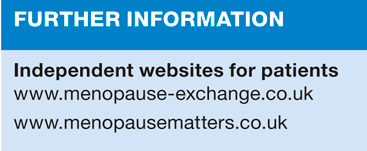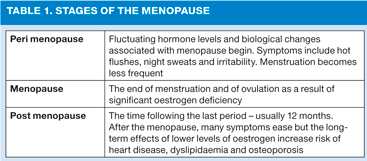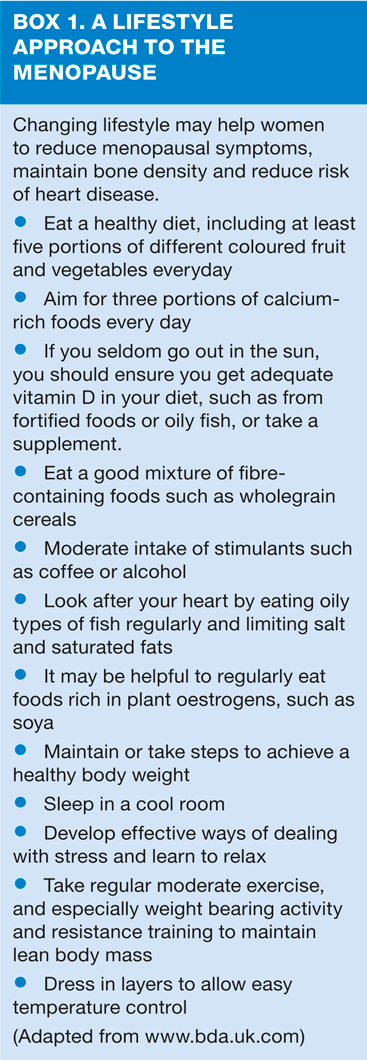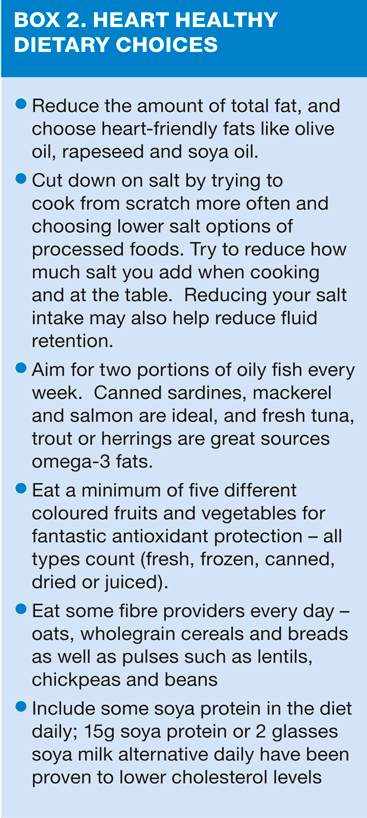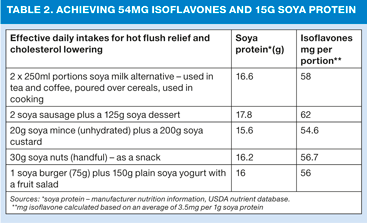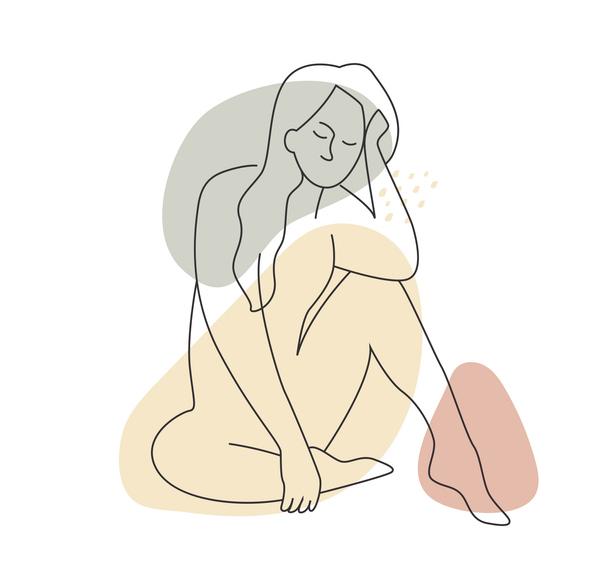
Advising women on the menopause and diet
Dr Frankie Phillips
Dr Frankie Phillips
RD
Registered dietitian and Public Health Nutrition Consultant, Torquay, Devon
Dietary measures can prove helpful both in minimising the symptoms associated with the menopause, and in reducing the long term risk of cardiovascular disease and osteoporosis.
The menopause is a is a significant milestone in a woman's life, usually occurring between the ages of 45-55 years, and signalling an end to the fertile years, a time of significant alterations in hormone balance, mainly the loss of oestrogen, with considerable health and well-being consequences.1 Despite the increased risk of cardiovascular disease and osteoporosis, for the majority of women, relief from hot flushes takes precedence over other health considerations. With many sufferers seeking non-medical remedies, this article focuses on the role that healthy diet can play in minimising the risk of chronic diseases after menopause, as well as new evidence for dietary management of hot flushes.
THE MENOPAUSE AND ITS IMPLICATIONS
The menopause results from significant hormonal changes with a marked reduction in oestrogen production. In the UK, the average age of women experiencing the natural menopause is 51 years, but it can occur anytime between the ages of 45 and 55 years.1 Younger women (under 40 years) undergoing a hysterectomy or cancer treatments - impacting on the ovaries' ability to produce progesterone and oestrogen - will also experience a premature menopause, and the symptoms associated with menopause will have earlier onset.
Menopausal symptoms are primarily due to falling oestrogen levels, and may last for just a few months or linger for several years. In terms of health, a multitude of psychological, sexual and physical symptoms may be experienced. Symptoms differ between women, but can include vasomotor symptoms (such as hot flushes), night sweats, irritability, poor concentration, frequent headaches and joint pains, reduced sex drive and vaginal dryness and weight gain. Over the long-term, the loss of oestrogen results in elevated risk of cardiovascular disease and osteoporosis.
Hormone replacement therapy (HRT) is a very effective means of controlling menopausal symptoms, alleviating 90% of vasomotor symptoms within three months of starting treatment.2 However, results from large trials, reporting that HRT increases risk of cardiovascular disease and breast cancer have led women to seek alternative treatments, and HRT use by UK women has declined from 30% to 10%, with many seeking natural and non-medicinal options.2 There are over 200 non-medical treatments including relaxation and meditation techniques and numerous botanical options such as Evening Primrose Oil, Red Clover, Black Cohosh and phytoestrogens.3 The clinical evidence for most is far from adequate for health professionals to confidently make recommendations for their use. However, healthy nutrition and lifestyle changes can play an important role in the treatment of menopausal symptoms and long-term health risks, but changes should be followed for at least three months to allow the full potential benefits to be seen. (Box 1)
WEIGHT GAIN
Unless physical activity of a moderate intensity is maintained to prevent muscle loss, there is a slow but significant reduction in lean muscle tissue during the menopause, which can result in a reduced requirement for energy (calories). This can add up over time, resulting in gradual weight gain. Being overweight is known to make menopausal symptoms, such as hot flushes, worse. Moderating energy intake and increasing energy expenditure through daily physical activity can make a real difference. Thirty minutes extra brisk walking a day could lead to around 7kg (15lb) weight loss in a year, and significantly reduce the risk of heart disease.
BONE HEALTH
From the age of about 35, there is a slow loss of bone density in both men and women. However, during menopause, reduced oestrogen levels cause an increased rate of loss of calcium from the skeleton. This is more common in menopausal women who are not on HRT, as HRT replaces oestrogen. Nutrition has a significant impact on bone health, so it's important that the diet is balanced with plenty of fruit and vegetables and adequate calcium. Patients should be advised to aim for three portions of calcium-rich foods every day: a third of a pint/ 200ml semi-skimmed milk, a matchbox size piece of cheese, a small yoghurt (dairy or calcium-fortified soya variety) or canned fish (where soft bones are eaten, e.g. sardines and pilchards).
Vitamin D, which is synthesised in the skin from sunlight, is also important for bone health and women who have low sunlight exposure may need to consider taking a Vitamin D supplement. Women who have been diagnosed with osteoporosis may be prescribed a bone health supplement including calcium and vitamin D. [See also Nutrition and Bone Health in the UK: Calcium and vitamin D from cradle to grave. Practice Nurse 26 October 2012;42(16)26-30]
HEART HEALTH
Before the menopause, there is a lower prevalence of coronary heart disease (CHD) among women, compared with men, largely resulting from the protective effect of oestrogen. After approximately 50 years of age, with the deficiency in oestrogen, there is a sharp increase in CHD rates among women. Large-scale population studies suggest that around the time of the menopause, low-density lipoprotein cholesterol (LDL-C) levels increase by approximately 15-25%, placing women at significantly higher risk of heart disease.4 In the UK, in 2008, the proportion of women aged 16-24 with elevated cholesterol (over 5.0mmol/l) was 36%, compared with 83% in those aged 55-64.5 Despite increased risk, elevated cholesterol levels are not immediately experienced around the menopause, unlike vasomotor symptom, and women may often neglect this risk factor. Therefore, it is of paramount importance that menopausal women are made aware of health dietary choices (see BOX 2).
HOT FLUSHES
Despite the heightened risk of osteoporosis and heart disease, menopausal women's primary concern and reason for seeking advice from health professionals is the onset of hot flushes. Hot flushes, and other vasomotor symptoms, are by far the most common and disturbing symptom as reported by 70-80% of menopausal women, especially during the peri-menopausal years.6 The incidence of hot flushes varies significantly between cultures and between individuals. Seventy four percent of European women complain of hot flushes compared with only 22-63% of Asian women.7 However, there are significant inter and intra culture differences.2
A hot flush is a transient phenomenon of a sensation of all-over warmth, followed by a shivering sensation, and is a vasomotor response to a lack of oestrogen, leading to a decrease in cardiac vagal control. Although not fully understood, vasomotor symptoms are thought to result from fluctuations in the brain's temperature-regulating system as a consequence of the decline in oestrogen levels.1,7 Hot flushes can vary in frequency and severity and can last from a few seconds to a few minutes, and in some cases for a couple of hours, sometimes accompanied by sweating, palpitations, redness and anxiety.1,7 Symptoms generally begin in the peri-menopausal stage and persist for one to five years after menstruation stops.8 However, a recent large UK survey found that for over 50% of women, hot flushes can last for up to 10 years.9 Up to a quarter of sufferers actively seek medical or alternative therapy.
SOYA ISOFLAVONES
Phytoestrogens are a group of substances found in plant foods. They are structurally similar, but hundreds of times weaker than human oestrogen. Major studies have examined the potential role of soya isoflavones in managing hot flushes, since women in Asian countries, where the diet typically contains high amounts of soya, report far fewer hot flushes.8 It is the phytoestrogens present in soya (isoflavones) that are thought to be responsible for the alleviation of symptoms; isoflavones consumption in Europe is typically less than 3mg per day, whereas in Japan it is 25-50mg per day.10,11
Large clinical studies have examined the potential role of soya-specific isoflavones in the management of hot flushes in reducing their frequency and severity.12-14 Although results have been conflicting, a robust meta-analysis using studies with least publication bias has confirmed previous systematic review findings and provides some clear conclusions.14 The meta-analysis of 19 clinical studies collated data from over 1,500 women experiencing hot flushes. All studies used soya-derived isoflavone supplements in the treatment group, with a median daily intake of 54mg (range 30mg-135mg). For subjects who experienced at least five hot flushes per day, a median intake of 54mg isoflavones daily for at least 6 weeks reduced hot flush frequency by more than 20% beyond placebo (p<0.00001). The optimum impact was seen for those taking the isoflavones for at least 12 weeks. Soya isoflavones also reduced hot flush severity, with a median 54mg daily dose of isoflavones reducing the severity of hot flushes by 26.2% beyond placebo (p=0.0001).
This meta-analysis clearly demonstrates that for women seeking relief from hot flushes, who are unable or unwilling to take HRT, soya isoflavones could be an alternative option.
Recommending soya foods, rather than isoflavone supplements alone, can provide multiple health benefits to menopausal women. As well as providing isoflavones, soya foods are naturally low in saturated fat and the replacement of animal proteins with soya proteins can help to lower overall saturated fat intake. In addition, soya protein has been shown to actively lower cholesterol levels by down-regulating endogenous LDL-C synthesis.15,16 Soya foods can therefore not only provide an alternative option for hot flush relief but have the potential to reduce CHD risk. Meta-analyses have demonstrated that LDL-C reductions of up to 10% can be achieved from as little as 15g soya protein per day, or one to two servings of soya foods;15,16 similar quantities of soya foods are needed to achieve the hot flush relief dose of 54mg of isoflavones (see Table 2).
CONCLUSION
Menopause is a time of significant health changes and women should be well informed of the potential changes in risk of chronic conditions. For women who are particularly affected by hot flushes, a lifestyle approach to managing the menopause is recommended. Health professionals should feel confident in encouraging their menopausal patients experiencing at least 5 hot flushes daily, and seeking alternative therapy, or unable to use HRT to trial soya foods, providing around 54mg isoflavones (two large glasses of soya milk alternative) every day for up to 12 weeks to make a noticeable difference and this may also reduce risk of CHD.
REFERENCES
1. Morris EP and Burbos N. Menopausal symptoms. Clin Evid (Online). 2010 Feb 25;2010. pii:0804.
2. Menon U, Burnell M, Sharma A et al. UKCTOCS Group. Decline in women using hormone replacement therapy at recruitment to a large screening trial in the United Kingdom. Menopause 2007;14:462.
3. Hazel A. Philp, ND. Hot Flashes - A Review of the Literature on Alternative and Complementary Treatment Approaches. Alternative Medicine Review 2003;8:283-302
4. Davidson MH, Maki KC, Karp SK, Ingram KA. Management of hypercholesterolaemia in postmenopausal women. Drugs and Aging 2002;19(3):169-78.
5. British Heart Foundation. Coronary Heart Disease Statistics 2010. http://www.bhf.org.uk/publications/view-publication.aspx?ps=1001546 (accessed June 2012)
6. Knight DC, Eden JA Phytoestrogens, a short review Maturitas. 1995;22:167-75.
7. Archer DF, Sturdee DW, Baber R et al. Menopausal hot flushes and night sweats: where are we now?' Climacteric 2011;14:515-28.
8. Gold EB, Colvin A, Avis N et al. Longitudinal analysis of the association between vasomotor symptoms and race/ethnicity across the menopausal transition: Study of women's health across the nation. Am J Public Health 2007; 96:1226-1235.
9. Hunter MS, Gentry-Maharaj A, Ryan A et al. Prevalence, frequency and problem rating of hot flushes persist in older postmenopausal women: impact of age, body mass index, hysterectomy, hormone therapy use, lifestyle and mood in a cross-sectional cohort study of 10,418 British women aged 54-65. BJ Obstet Gynaecol 2012;119:40-50.
10. van Erp-Baart MA, Brants HA, Kiely M et al. Isoflavone intake in four different European countries: the VENUS approach. Br J Nutr. 2003;89(Suppl 1):S25-30.
11. Messina M, Nagata C, Wu AH. Estimated Asian adult soy protein and isoflavone intakes. Nutr Cancer 2006;55:1-12.
12. Kurzer MS. Review: Soy consumption for reduction of menopausal symptoms Inflammopharmacology 2008;16:227-229
13. Ferrari A. Soy extract phytoestrogens with high dose of isoflavones for menopausal symptoms . J Obstet Gynecol Res 2009;35:1083-1090.
14. Taku K. Melby MK, Kronenburg F et al. Extracted or synthesized soybean isoflavones reduce menopausal hot flash frequency and severity: systematic review and meta-analysis of randomized controlled trials. Menopause 2012;19:776-90
15. Harland JI and Haffner TA. Systematic review, meta-analysis and regression of randomized controlled trials reporting an association between an intake circa 25g soya protein per day and blood cholesterol. Atherosclerosis 2008; 200:13-27.
16. Jenkins DJ, Mirrahimi A, Srichaikul K, et al. Soy protein reduces serum cholesterol by both intrinsic and food displacement mechanisms. J Nutr 2010;140:2302S-2311S.
Related articles
View all Articles
